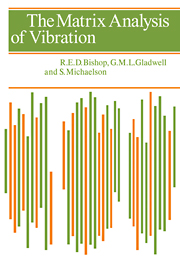Book contents
- Frontmatter
- Contents
- Preface
- Chapter 1 Notation and elementary properties of matrices
- Chapter 2 The vibration of conservative systems having a finite number of degrees of freedom
- Chapter 3 Linear equations
- Chapter 4 Further development of the theory of conservative systems
- Chapter 5 Damped forced vibration
- Chapter 6 Continuous systems
- Chapter 7 The solution of linear equations and the inversion of matrices
- Chapter 8 Iterative methods for characteristic value problems
- Chapter 9 Direct methods for characteristic value problems
- Appendix
- Answers to examples
- Index
Chapter 2 - The vibration of conservative systems having a finite number of degrees of freedom
Published online by Cambridge University Press: 24 November 2009
- Frontmatter
- Contents
- Preface
- Chapter 1 Notation and elementary properties of matrices
- Chapter 2 The vibration of conservative systems having a finite number of degrees of freedom
- Chapter 3 Linear equations
- Chapter 4 Further development of the theory of conservative systems
- Chapter 5 Damped forced vibration
- Chapter 6 Continuous systems
- Chapter 7 The solution of linear equations and the inversion of matrices
- Chapter 8 Iterative methods for characteristic value problems
- Chapter 9 Direct methods for characteristic value problems
- Appendix
- Answers to examples
- Index
Summary
If you ask the special function
Of our never-ceasing motion,
We reply, without compunction,
That we haven't any notion!
IolantheIn this chapter we shall commence our discussion of the small oscillations of dynamical systems having a finite number of degrees of freedom. It will be assumed that there are no forces proportional to velocity acting on the systems; this will exclude damping and gyroscopic effects. It will mean also that the systems are ‘conservative’, since forces depending on displacements may always be obtained from a potential function. Our purpose in this chapter is to cast the theory of these systems into matrix form.
The reader who is already familiar with the basic theory, and who wishes immediately to pass on to the application of matrices in it should turn directly to § 2.1. For the benefit of readers who require either an introduction to the theory or a brief review of it, however, an introductory ‘§2.0’ is given which has no direct connection with matrix theory.
Introduction
The analytical determination of the vibration behaviour of a physical system may be divided into a number of stages:
The choice of a mathematical model which is to be used to represent the physical system. If the system were a wing of an aircraft, for instance, it would have to be decided whether to treat it as a continuous beam in flexure and/or torsion, as a plate or a box-like structure, as some lumped-mass system, or as some other type of system.
[…]
- Type
- Chapter
- Information
- The Matrix Analysis of Vibration , pp. 36 - 94Publisher: Cambridge University PressPrint publication year: 1979

